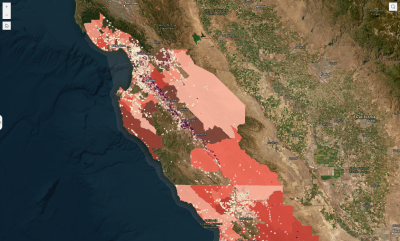New Media Tool Shows Extent of Nitrate Contamination in California's Central Coast

For Immediate Release
Media Contacts
- Elias Rodriguez, Staff Attorney, California Rural Legal Assistance, Inc.
(831) 757-5221 | erodriguez@crla.org - Natalie Herendeen, Executive Director, Monterey Waterkeeper
(831) 204-1381 | natalie@montereywaterkeeper.org
New Media Tool Shows Extent of Nitrate Contamination in California's Central Coast
Rural communities partner with Stanford student, Santa Clara University Water and Climate Justice Lab to document their clean water advocacy
July 7, 2025 – Salinas, CA – Central Coast communities published a new story map, “A Fight for Clean Water on the Central Coast,” which shows pervasive nitrate contamination from synthetic fertilizer leached into the region’s drinking water.
Rural communities throughout the Central Coast region have long endured the negative health and economic impacts of being exposed to unsafe drinking water. To tell the story about their resilience and advocacy for a better, healthier future, the communities teamed up with local partners and academic institutions to create this story map.
The story map highlights that census tracts with predominant Latinx populations are 4.4 times more likely than non-Latinx populations to be exposed to drinking water that exceed state safety standards for nitrate.
“For twelve years San Lucas has been on a do not drink order, and for decades we have endured pollution in our drinking water,” says E. Valentin Resendiz-Luna, president of Misión San Lucas, one of the Central Coast community groups. “Through the story map, we are able to share these struggles about how agricultural operations affect our daily lives with our neighbors, our fellow farmworkers, and the public.”
Amanda Cheng, a Stanford University student and primary creator of the story map, reflected on the process, “My part was easy compared to what these communities are experiencing.”
Cheng states that she used the skills she learned in her Stanford University Earth Systems courses to display the data to highlight the disproportionate impacts of nitrate pollution on low-income communities and communities of color: “It was a pleasure to support community groups in their work advocating for equitable access to clean water.”
The publication of the story map coincides with the publication of a Santa Clara University Magazine article highlighting the cutting-edge partnership between the Water and Climate Justice Lab at Santa Clara University (the Lab), led by Iris Stewart-Frey, and communities facing the nitrate contamination crisis.
Jake Dialesandro, a Lecturer and Geospatial Scientist for the Lab highlights that, “The data tells the story itself—Latinx communities are disproportionately exposed to unsafe drinking water and therefore disproportionately exposed to negative health risks such as Blue Baby Syndrome.”
Ellie Heinrichs, a student in the Lab, created the Spanish version of the story map because she understood the importance of disseminating the media tool in the Spanish language.
Jasmine Huerta Ponce, a community worker for California Rural Legal Assistance, Inc., the nonprofit law firm representing the community groups, affirms, “farmworkers constantly struggle against the power differential between them and their employers.”
“Historically,” Huerta Ponce says, “the $4 billion regional agricultural industry has been well-resourced to tell their side of the story. It is only right that communities have access to the same quality media tools to tell their side—to explain the hardships they endure to support the food system and their dream to thrive despite facing some of the worst harms of industrial agriculture.”
Rosa Carrillo, General Manager of San Jerardo Cooperative (the Cooperative) says, “It is unfair for the residents of San Jerardo Cooperative to have to go through the trauma of not having clean water again. Due to the negligence of some agricultural companies and due to the State Water Board’s failure to enforce stricter limits, our groundwater is unprotected.”
The Cooperative is a resident-owned community located southeast of Salinas, California and has deep roots in clean water advocacy. Farmworker families purchased the Cooperative during President Johnson’s “War on Poverty.”
The story map also tells the story of groundbreaking advocacy efforts to improve drinking water safety. Currently, community members and advocates are working with the Central Coast Regional Water Quality Control Board to establish an alternative water supply program where agricultural operations will contribute to short- and long-term drinking water solutions for nitrate-contaminated communities.
Separately, beginning this summer, the State Water Resources Control Board will convene an expert panel tasked with making recommendations on how to set limits on synthetic fertilizer. The panel will also analyze how to incentivize agricultural practices that reduce the harm of the food system on rural, low-income, farm-working communities.
“All communities ought to be involved in these advocacy efforts. No matter who you are, you’ll see the effects of agricultural pollution in your future, if not already—whether it’s through higher water rates or higher taxes to subsidize infrastructure projects that address water pollution. So, all California residents ought to be informed of the facts,” says Resendiz-Luna.
The Misión San Lucas president further encourages readers to, “navigate through the story map, to inform yourself about these facts.” He reminds readers that, “When you’re advocating at the state or regional board level,” to, “always remember the stories of community members on the frontlines, doing the back-breaking work in the fields to put food on the table worldwide—and thriving—even while facing the disproportionate health impacts of agricultural pollution.”
###
About California Rural Legal Assistance, Inc.
California Rural Legal Assistance, Inc. (CRLA) is an anti-poverty law firm that dismantles unjust systems through community lawyering in California’s historically rural areas. We work with people priced out of private legal representation so they can uphold civil rights in housing, employment, health, and public education. Through our 17 Rural Justice Centers, communities can access a broad range of legal tools, including direct legal services, place-based advocacy to expand equity in civic institutions, and specialized litigation to advance civil rights.
crla.org
About Monterey Waterkeeper
Monterey Waterkeeper is a not-for-profit organization that protects and restores fishable, swimmable, and drinkable waters within the Monterey Region and along California's Central Coast for all to enjoy.
www.montereywaterkeeper.org

